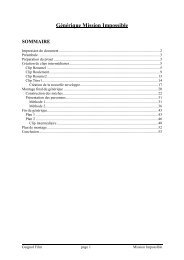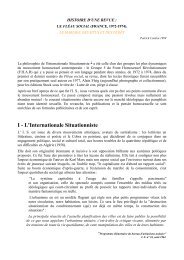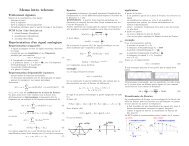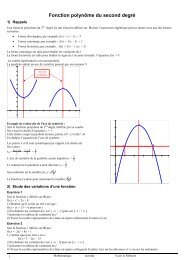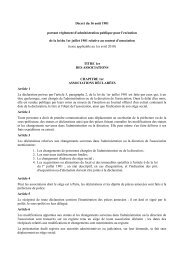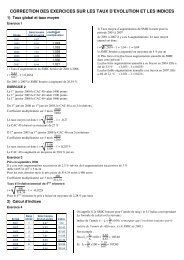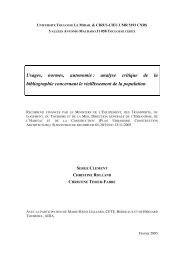internationalisation in science in the prism of bibliometric indicators
internationalisation in science in the prism of bibliometric indicators
internationalisation in science in the prism of bibliometric indicators
Create successful ePaper yourself
Turn your PDF publications into a flip-book with our unique Google optimized e-Paper software.
Border-free competition and co-operation are <strong>in</strong> <strong>the</strong> heart <strong>of</strong> selforganisation<br />
<strong>of</strong> <strong>science</strong>.<br />
The second eng<strong>in</strong>e <strong>of</strong> <strong><strong>in</strong>ternationalisation</strong> lies <strong>in</strong> <strong>the</strong> top-down<br />
processes, which ga<strong>in</strong>s full power after WWII. Mult<strong>in</strong>ational programmes<br />
associate clubs <strong>of</strong> countries with reasonably converg<strong>in</strong>g political<br />
objectives, ei<strong>the</strong>r on an occasional or permanent basis. Top-down<br />
processes and self-organisation <strong>in</strong>teract <strong>in</strong> many ways <strong>in</strong> large-scale<br />
programs: cost-shar<strong>in</strong>g <strong>of</strong> large facilities 1 (physics/ astrophysics),<br />
co-ord<strong>in</strong>ation <strong>of</strong> large programs (genome). Supranational entities, first<br />
<strong>of</strong> all EU, become an important source <strong>of</strong> coord<strong>in</strong>ation and fund<strong>in</strong>g <strong>of</strong><br />
programs aim<strong>in</strong>g at convergence and <strong>in</strong>tegration <strong>of</strong> member countries,<br />
with a heavy Science-Technology-Innovation folder. Framework<br />
programmes, <strong>in</strong>centives to network<strong>in</strong>g and mobility, efforts to harmonise<br />
<strong>of</strong> higher education systems, and currently <strong>the</strong> European Research Area<br />
<strong>in</strong>itiative are expected to enhance cohesion and competitiveness <strong>of</strong><br />
Europe.<br />
A third eng<strong>in</strong>e has ga<strong>in</strong>ed force <strong>in</strong> <strong>the</strong> last decades, namely <strong>the</strong><br />
general movement <strong>of</strong> f<strong>in</strong>ancial and economic globalisation. It has been<br />
celebrated as a strong mechanism <strong>of</strong> diffusion <strong>of</strong> knowledge, <strong>in</strong><br />
particular through mult<strong>in</strong>ational firms. R&D services implementation and<br />
<strong>the</strong>ir articulation with local research are <strong>of</strong>ten viewed as an important<br />
<strong><strong>in</strong>ternationalisation</strong> eng<strong>in</strong>e. Academic research is enrolled through<br />
tighter l<strong>in</strong>kages with technology and markets. An echo <strong>of</strong> <strong>the</strong> <strong>in</strong>creas<strong>in</strong>g<br />
pressures on Mertonian model is found <strong>in</strong> <strong>the</strong> "new economics <strong>of</strong> <strong>science</strong>"<br />
(Dasgupta & David, 1994, David & Foray, 1995, Stephan, 1996; for a<br />
contrast<strong>in</strong>g view see Callon, 1994).<br />
Br<strong>in</strong>g<strong>in</strong>g drastic cuts <strong>in</strong> communication costs, <strong>the</strong> new Information<br />
and Communication Technology (ICT) and Internet revolution has boosted<br />
immaterial exchanges and especially scientific work. The prototype at<br />
European Organisation for Nuclear Research (CERN) which turned <strong>in</strong>to <strong>the</strong><br />
world web was already aimed at communication between scientists. More<br />
generally, <strong>the</strong> ICT revolution and <strong>the</strong> explosion <strong>of</strong> electronic networks<br />
have been acclaimed as abolish<strong>in</strong>g distances and announc<strong>in</strong>g "<strong>the</strong> death<br />
<strong>of</strong> geography".<br />
2. Adverse mechanisms<br />
These strong pressures towards <strong><strong>in</strong>ternationalisation</strong> face adverse<br />
mechanisms that can be subsumed with<strong>in</strong> "proximity effects" <strong>of</strong> various<br />
k<strong>in</strong>ds. They tend to channel preferential relations between actors close<br />
to each <strong>in</strong> various dimensions: geographic, cultural and l<strong>in</strong>guistic,<br />
<strong>in</strong>stitutional, <strong>the</strong>matic, etc. Moreover, some proximity effects are<br />
anchored <strong>in</strong> territorial <strong>in</strong>frastructure or cultural and l<strong>in</strong>guistic<br />
sociability, which confer a strong stability.<br />
The first example is <strong>the</strong> resilience <strong>of</strong> <strong>the</strong> national level. The<br />
nationalist resistance to globalisation <strong>of</strong> scientific communities,<br />
which peaked <strong>in</strong> <strong>the</strong> periods <strong>of</strong> world wars and also <strong>of</strong> cold war, is out<br />
<strong>of</strong> fashion, though enrolment <strong>of</strong> <strong>science</strong> <strong>in</strong> strategic technology, not<br />
1 on <strong>the</strong> scientific <strong>in</strong>frastructure see Irv<strong>in</strong>e et al.(1997)




